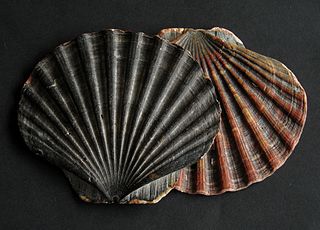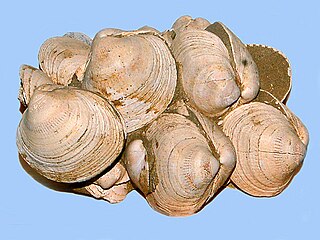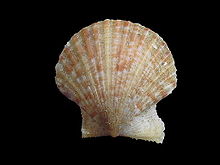
Spondylus is a genus of bivalve molluscs, the only genus in the family Spondylidae. They are known in English as spiny oysters.

Crepidula fornicata is a species of medium-sized sea snail, a marine gastropod mollusc in the family Calyptraeidae, the slipper snails and cup and saucer snails. It many common names, including common slipper shell, common Atlantic slippersnail, boat shell, quarterdeck shell, fornicating slipper snail, Atlantic slipper limpet and it is in Britain as the "common slipper limpet".

The queen scallop is a medium-sized species of scallop, an edible marine bivalve mollusk in the family Pectinidae, the scallops. It is found in the northeast Atlantic and is important in fisheries.

Nodipecten is a genus of large scallops, marine bivalve molluscs in the family Pectinidae, the scallops. These scallops often have attractive, strongly colored, thick shells. The generic name Nodipecten means "nodular scallop", because in this genus the shell is usually sculpted with regular, very large nodes.

Cerastoderma is a genus of marine bivalves in the family Cardiidae. It includes the common cockle Cerastoderma edule.

The Plicatulidae are a family of saltwater clams, marine bivalve mollusks, known commonly as kitten's paws or kittenpaws. These bivalves are related to oysters and scallops. The family has a single living genus, Plicatula, with a second, Harpax known from fossils.

Chlamys is a genus of small scallops, marine bivalve molluscs in the family Pectinidae. The name is taken from the Ancient Greek, χλαμΰς or Chlamys, a cloak worn by soldiers.

Dentalium is a large genus of tooth shells or tusk shells, marine scaphopod molluscs in the family Dentaliidae. The genus contains 50 described species and about 50 extinct species.

Pecten is a genus of large scallops or saltwater clams, marine bivalve molluscs in the family Pectinidae, the scallops. This is the type genus of the family.

Pecten maximus, common names the great scallop, king scallop, St James shell or escallop, is a northeast Atlantic species of scallop, an edible saltwater clam, a marine bivalve mollusc in the family Pectinidae. This is the type species of the genus. This species may be conspecific with Pecten jacobaeus, the pilgrim's scallop, which has a much more restricted distribution.

Argopecten is a genus of saltwater clams, or scallops, marine bivalve mollusks in the family Pectinidae.

Argopecten irradians, formerly classified as Aequipecten irradians, common names Atlantic bay scallop or bay scallop, is a marine bivalve mollusk in the family Pectinidae, a species of scallop. An edible saltwater clam, it is native to the northwest Atlantic from Cape Cod to the Gulf of Mexico.

Cymatium is a genus of small to large predatory sea snails, marine gastropod mollusks in the family Cymatiidae.
Tumidotheres maculatus is a species of crab that lives commensally or parasitically in the mantle cavity of molluscs. It is found along much of the western Atlantic Ocean and was first described by Thomas Say in 1818.
Euvola is a genus of marine bivalve mollusks in the family Pectinidae, the scallops. In shells of this genus, one valve is flat, and the other is deeply cupped.

Trachycardium is a genus of molluscs in the family Cardiidae.

Glycymeris, common name the bittersweet clams, is a genus of saltwater clams, marine bivalve molluscs in the family Glycymerididae.

Antalis is a genus of tusk shells, marine scaphopod mollusks.

Flexopecten is a genus of saltwater scallops, marine bivalve mollusks in the family Pectinidae, the scallops.

















